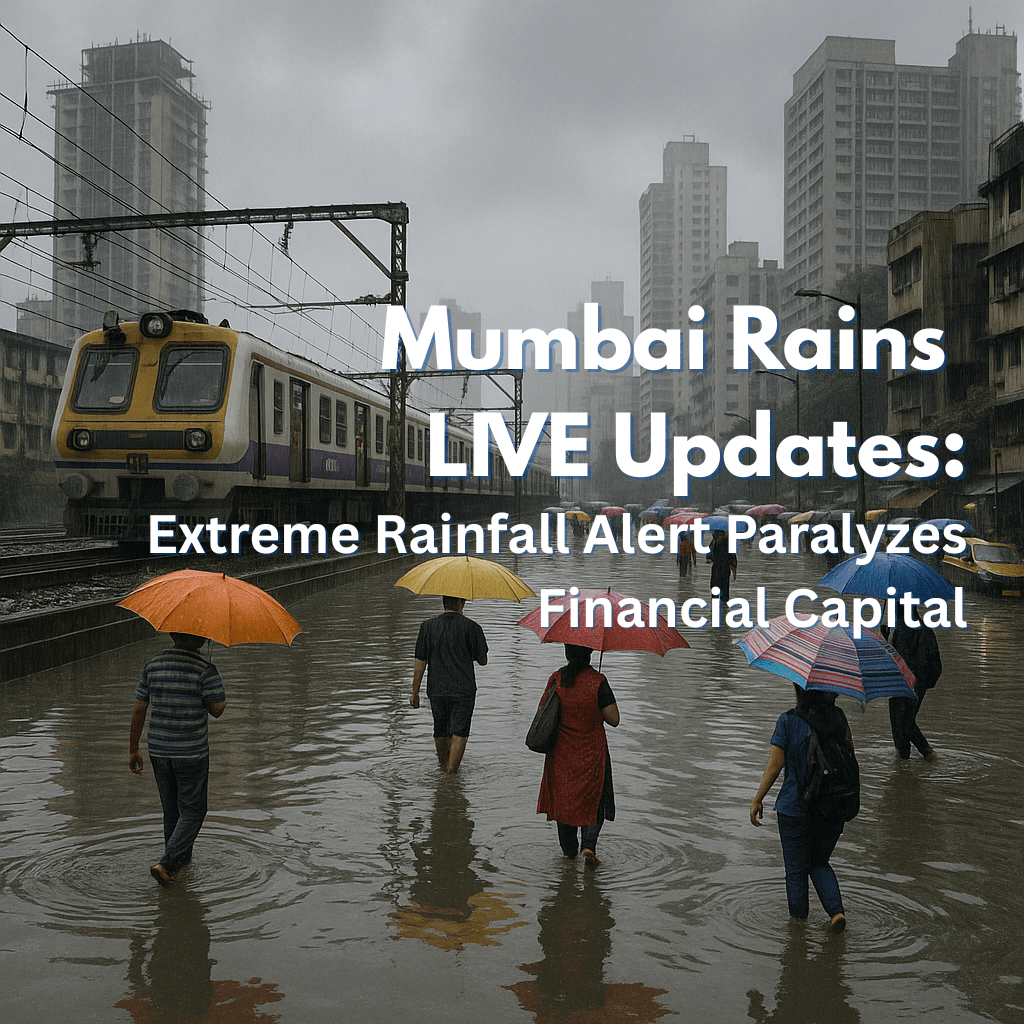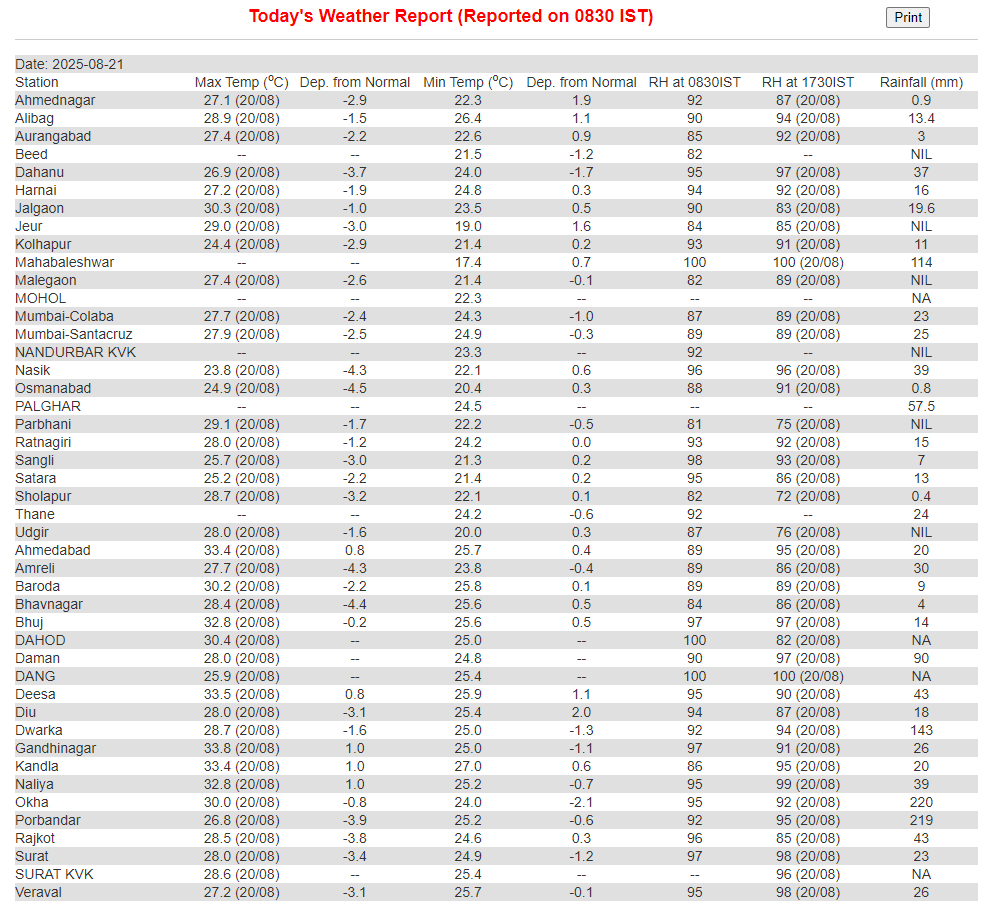
Mumbai Rains LIVE Updates: Extreme Rainfall Alert Paralyzes Financial Capital

Mumbai, India’s financial capital, is witnessing one of its wettest August spells in five years as extreme rainfall alert continues to grip the metropolis. The city has been battered by relentless monsoon fury for over four consecutive days, with the India Meteorological Department (IMD) issuing Mumbai Rains LIVE Updates warnings and authorities scrambling to manage the crisis. Today’s news brings updates on improving conditions, though the city continues to grapple with the aftermath of unprecedented downpours.
Current Weather Status and IMD Alerts

As of August 21, 2025, the IMD has downgraded its alert level to yellow for Mumbai, marking a significant improvement from the red alerts that dominated earlier this week. The rainfall warning system has seen a systematic reduction in intensity:
- Yellow Alert: Currently active for Mumbai, indicating moderate to heavy rainfall spells
- Orange Alert: Continues for Pune and surrounding ghat areas
- Red Alert: Lifted from Mumbai but remains for certain parts of Maharashtra
The weather department forecasts that rainfall activity will continue to decrease over Konkan and Madhya Maharashtra regions over the next three days, providing much-needed relief to the beleaguered city.
Record-Breaking Statistics on Mumbai Rains LIVE Updates
Mumbai has experienced extraordinary precipitation levels that have shattered recent records. The city has already surpassed its monthly average rainfall quota for August, which typically stands at 566 mm. In just four days, Mumbai recorded 791 mm of rainfall – nearly matching the entire July total of 798 mm, which is generally the city’s wettest month.
Key rainfall statistics include:
- 300 mm of rain recorded in just 24 hours during peak intensity
- Over 200 mm rainfall between 4 AM and 3 PM on Tuesday alone
- Seasonal rainfall has crossed 2,322.43 mm since June 1, 2025
- Specific areas like Vikhroli recorded 262 mm in 24 hours
Mithi River Mumbai: Critical Flood Situation
The Mithi River Mumbai has emerged as a focal point of concern during this monsoon crisis. The river, which flows through crucial parts of Mumbai including Dharavi and Bandra Kurla Complex, witnessed dangerous water level rises:
- Water level reached 3.9 meters on Tuesday morning, dangerously close to the 4.2-meter danger mark
- Over 350 residents from Kurla’s Kranti Nagar were evacuated as a precautionary measure
- The swollen river caused flooding in nearby settlements, including Ambedkar Nagar
- Environmental concerns arose as flooding brought snakes, including pythons, into residential areas
The Mithi River’s overflow triggered memories of the catastrophic floods of July 26, 2005, when Mumbai recorded 944 mm of rainfall in 24 hours, emphasizing the critical importance of monitoring this waterway.
Transportation Disruptions and Recovery
Local Train Services
Mumbai’s lifeline – the local train network – faced severe disruptions but has shown signs of recovery:
Current Status:
- Harbour line services fully restored by 3 AM on Wednesday after 15+ hours of suspension
- Central and Western Railway services running with delays ranging from 5-26 minutes
- Multiple train cancellations occurred on August 20, with a comprehensive list issued by Mumbai Division of Western Railway
Impact Assessment:
- Services were suspended at around 11:15 AM on Tuesday due to waterlogged tracks
- Thousands of commuters were stranded on platforms with delays extending for hours
Flight Operations
Mumbai’s Chhatrapati Shivaji Maharaj International Airport experienced significant operational challenges:
Disruption Statistics:
- Over 250 flights affected during peak rainfall period
- 21 flights delayed, 2 cancelled, and over 40 running behind schedule as of August 20
- 12 flight diversions to cities including Ahmedabad, Surat, and Hyderabad
- Average delay of 54 minutes for departing flights
Airline Response:
Major airlines including IndiGo, SpiceJet, Akasa Air, and Air India issued comprehensive travel advisories, warning passengers about potential delays and recommending early departure for airport commute due to waterlogged roads.
Educational Institutions and Government Response
School and College Closures
The educational sector faced significant disruptions with varying policies across the region:
- August 18-19: BMC officially closed all schools and colleges in Mumbai
- August 20: Despite circulating rumors, BMC clarified that schools remained open, dismissing fake closure notifications on social media
- Neighboring areas: Panvel, Navi Mumbai, Thane, and Palghar declared holidays for August 20
- University impact: Mumbai University postponed examinations scheduled for Wednesday to August 23
Emergency Response Measures
Authorities deployed extensive resources to manage the crisis:
NDRF and SDRF Operations:
- 18 NDRF teams and 6 SDRF teams positioned across Maharashtra
- 293 people rescued by SDRF in Mukhed taluka, Nanded district
- Specialized rescue operations conducted in Kurla’s Kranti Nagar with boats and rescue gear
Casualty Statistics:
- 21 deaths reported across Maharashtra between August 15-19
- 6 fatalities in the last 24 hours due to rain-related incidents
- One death in Mumbai due to electrocution, with additional injuries reported
Areas Most Affected by Waterlogging
Several chronic flooding spots experienced severe inundation despite previous infrastructure investments:
Critical Waterlogged Areas:
- Hindmata and King’s Circle: Despite BMC’s crore-rupee flood control investments, these areas remained waterlogged
- Kurla and surrounding areas: Lal Bahadur Shashtri Marg submerged under 5 feet of water
- Western Express Highway: Near Vile Parle experienced significant delays
- Kopar Khairane Underpass: Completely waterlogged
- Bandra Khar Link Road: Severe water accumulation reported
Infrastructure Challenges and Solutions
Flood Control Measures
The current crisis has highlighted the limitations of existing flood control infrastructure. Despite significant investments, including:
- Rs 16 crore underground inlet chamber at Gandhi Market, King’s Circle
- Rs 140 crore project at Hindmata for underground tanks and enhanced stormwater drains
BMC attributed continued flooding to neap tide conditions, where minimal difference between high and low tides prevents effective drainage through floodgates.
Water Supply Impact on Mumbai Rains LIVE Updates
The heavy rainfall had a positive impact on the city’s water reserves:
- Overall water stock in seven supplying lakes reached 95.12% on Wednesday
- This represents a 3 percentage point increase in 24 hours
- Morbe Dam reached 100% capacity at 88.14 meters
Public Safety Measures and Advisories
Authorities issued comprehensive safety guidelines for residents:
Key Safety Advisories:
- Stay indoors and avoid flood-prone areas
- Avoid unnecessary travel during peak rainfall periods
- Contact BMC helpline 1916 for emergency assistance
- Keep updated through official channels only, avoiding social media rumors
High Tide Warnings:
Climate Context and Expert Analysis
Meteorologists and climate experts have provided crucial context for understanding this extreme weather event:
Climate Factors:
- Mumbai is on track to potentially exceed its 2020 record of 48 inches of rainfall in August
- The city has already received 800mm of rain over four days, significantly exceeding August averages
- Climate experts warn that such intense rainfall events are becoming more common due to global warming
Historical Perspective:
After a prolonged dry spell in July, the return of extremely heavy rainfall around August 16 caught the city off-guard, as August typically sees decreased rainfall intensity compared to July.
Economic Impact and Recovery Efforts
Agricultural Damage
The rainfall’s impact extended beyond urban areas:
- Crops across 12-14 lakh hectares affected in Maharashtra
- Agricultural assessment to be conducted once rainfall subsides
- Chief Minister monitoring situation with Guardian Ministers
Business and Commercial Impact
The financial capital’s business operations faced significant disruptions:
- Major commercial areas like BKC experienced flooding due to Mithi River overflow
- Transportation delays affected workforce mobility
- Airport disruptions impacted business travel schedules
Technology and Monitoring Systems
Maharashtra’s disaster management approach incorporates advanced technology:
- Advanced technology deployed in disaster management rooms
- Real-time tracking of rainfall, wind patterns, and detailed mapping
- Updates issued every three hours during crisis periods
- Coordination with neighboring states regarding dam management
People Also Ask (PAA) Section
Q: Is Mumbai safe to travel during the current rainfall situation?
A: As of August 21, conditions have improved with a yellow alert in place. However, travelers should check flight and train schedules, allow extra commute time, and stay updated through official channels.
Q: Which areas of Mumbai are most prone to flooding during heavy rains?
A: Chronic flooding areas include Hindmata, King’s Circle, Kurla, areas along Mithi River, Western Express Highway near Vile Parle, and various underpasses throughout the city.
Q: How does the Mithi River affect Mumbai’s flooding situation?
A: The Mithi River is crucial as it flows through key parts of Mumbai. When it reaches danger levels (4.2 meters), surrounding low-lying areas face severe flooding, requiring evacuations.
Q: What should residents do if they live in flood-prone areas of Mumbai?
A: Residents should monitor official weather updates, keep emergency supplies ready, know evacuation routes, contact BMC helpline (1916) for assistance, and relocate to safer areas when advised by authorities.
Q: Are Mumbai schools and colleges open during heavy rainfall?
A: School closure decisions depend on the severity of weather alerts. Parents should check official BMC announcements and avoid believing unverified social media messages about closures.
Looking Ahead: Recovery and Preparedness
As Mumbai begins its recovery from this intense rainfall episode, several key focus areas emerge:
Immediate Priorities:
- Continued monitoring of Mithi River water levels
- Restoration of full transportation services
- Assessment of infrastructure damage
- Support for affected communities
Long-term Considerations:
- Review of flood control infrastructure effectiveness
- Enhanced early warning systems
- Improved drainage capacity in chronic flooding areas
- Climate resilience planning for increasing extreme weather events
The current situation demonstrates both the vulnerability and resilience of Mumbai’s urban systems. While the immediate crisis is subsiding with improved weather conditions, the experience provides valuable lessons for future monsoon preparedness.
As the extreme rainfall alert transitions to more manageable conditions, Mumbai’s recovery efforts continue. The city’s ability to bounce back from such challenges once again showcases the spirit of its 18 million residents, even as authorities work to strengthen infrastructure and response systems for future extreme weather events.
Stay informed through official channels and prioritize safety as Mumbai navigates through this challenging monsoon period.
You may also read this : https://trendingnowindia.in/extreme-rainfall-alert-in-mumbai/





